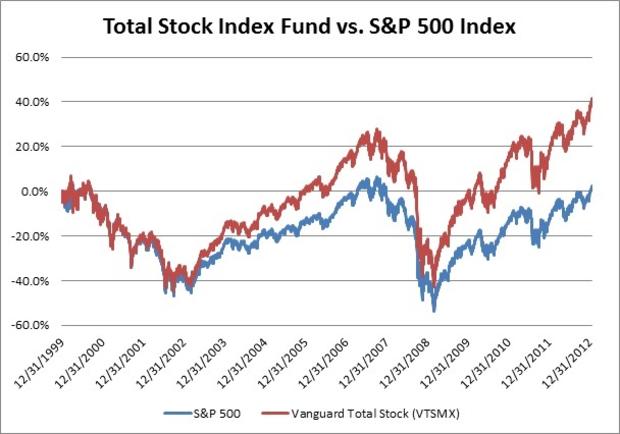Buy and hold investing discredited?
(MoneyWatch) A USA TODAY article earlier this week proclaimed stocks have gone nowhere in the past 13 years. The article stated:
The S&P 500 hit a bull market high of 1527.46 in March 2000. It closed at 1518.20 Friday. The point: From a pure price perspective, the benchmark index has lost money over the past 13 years. That lousy performance discredits buy-and-hold investing, says Zimmermann (technical analyst at United-ICAP).
Well, before you bury long-term buy and hold investing, let's look at some facts. Is it true that the S&P 500 index has gone nowhere since the turn of the century? It's absolutely true and completely misleading. The chart below shows the S&P 500 index compared to a buy and hold total stock market index fund. Though the S&P 500 index went nowhere, the index fund with dividends reinvested survived two 50 percent stock plunges and, as of last Friday, was up 43.1 percent.
I spoke to Walter Zimmerman and asked why he used the S&P 500 index, which excluded dividends, to illustrate U.S. stock returns rather than the total return of the stock market through a broad index fund or the Wilshire 5000 index total return. He explained that this was the only chart he had access to and it better explained investor sentiment. I next asked whether he had any data showing the total return of investors based on his company's charting service. He stated not at this time but that he could develop it over a few days.
Next, I sent an email to the USA Today writer, Adam Shell, as to why he used the S&P 500 index to make the point. I had previously communicated to him that Wall Street loves the media to quote this index so consumers would believe that part of the return of the largest 500 companies represented the U.S. stock market. Shell did not respond.
My take
It's in the interest of Wall Street for consumers to believe buy and hold is dead and professional investors rule. That's because professionals want you to think we can pick winning stocks and know how to time the market. Much of the media is willing to accommodate by giving misleading data and arriving at unsupported conclusions.
Buy and hold is far from dead and the only thing that works better is buy and hold and rebalance. Buying stocks after declines is not easy and made even harder by the media. Indeed, Shell wrote a story on March 9, 2009, the very day stocks bottomed, speculating to "card-carrying members of the buy-and-hold club" that it could take decades for stocks to recover. In actuality, if you invested $1,000 in a total stock index fund at the pre-crash high on October 9, 2007, you'd have $1,137 as of March 5, 2013, or a 13.7 percent gain. That's in less than four years, not decades. If you had ignored such bearish nonsense and rebalanced on Mach 9, 2009, your U.S. stock index would be up 155.2 percent.
Yet again, the death of buy-and-hold has been greatly exaggerated.
